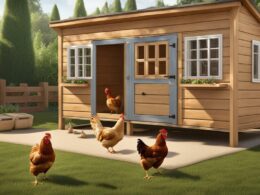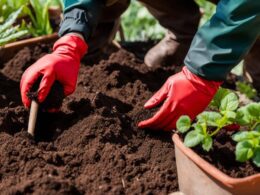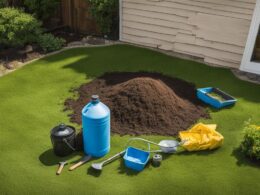If you live in an area where deer are common, you may have considered feeding them during the winter months. Providing food for deer can help them survive the harsh winter and is a great way to support the wildlife in your backyard.
However, it’s important to understand the dietary needs of deer and be aware of the potential risks associated with feeding them. This article will provide you with all the necessary information to feed deer safely and responsibly in your backyard during winter.
Post Summary:
- Feeding deer during winter is a great way to support wildlife in your backyard
- Understanding the dietary needs of deer and feeding them appropriately is important for their health and wellbeing
- Feeding deer in backyards comes with potential risks and legal and ethical considerations
Understanding Deer Dietary Needs in Winter
In winter, deer’s dietary needs change due to the lack of available food sources. They require a high-calorie diet to maintain their body weight and sustain them through the cold season.
Deer’s natural diet consists mainly of woody plants, grasses, and forbs. However, finding these food sources becomes increasingly challenging during winter, as snow and ice cover the ground, making it difficult for deer to access food.
Challenges Deer Face in Finding Food
Deer have to adapt to the changing environment and the limited availability of food sources during the winter. They face several challenges when looking for food, including:
- Dwindling food supplies as plants die or go dormant for the winter
- Snow and ice covering vegetation, making it difficult to access
- Deer’s reduced mobility and difficulty moving through snow
- Increased competition for food among deer, as well as other wildlife species
Deer’s Nutritional Requirements in Winter
Deer’s nutritional requirements in winter depend on several factors, including their age, sex, and body weight. However, in general, they require a high-calorie diet that provides enough energy to keep them warm and active through the winter months.
Deer need a diet that includes:
- High-energy foods, such as nuts, grains, and seeds
- Protein-rich food, such as soybeans and alfalfa
- Minerals, including calcium and phosphorus, to maintain strong bones
- Vitamins, such as vitamin E and A, to support their immune system and overall health
To meet these requirements, it’s essential to provide deer with a healthy and varied diet that includes both natural and supplemental food sources.
Natural Food Sources for Deer in Winter
Deer are adapted to foraging for food year-round, but their dietary needs change with the seasons. During winter, their main challenge is finding enough food to maintain their energy levels and stay warm. Fortunately, there are several natural food sources that deer rely on to survive during the colder months.
One of the most important sources of food for deer in winter is woody browse, which includes the leaves, twigs, and bark of trees and shrubs. Some of the preferred species of woody browse for deer include red maple, white pine, and red oak.
In addition to woody browse, deer also rely on herbaceous plants for sustenance. This includes a variety of grasses, sedges, and forbs, such as goldenrod, asters, and clovers. These plants are important sources of both carbohydrates and protein for deer.
In areas with wetlands, aquatic plants are another important food source for deer. Plants such as arrowhead, pickerelweed, and duckweed are highly nutritious and provide an important source of moisture for deer during winter.
Finally, fruits and nuts are an important supplement to deer diets in winter. Some of the preferred species for deer include acorns, apples, and persimmons. These foods are high in carbohydrates and provide much-needed energy for deer during the colder months.
How to Incorporate Natural Food Sources in Your Backyard
If you’re interested in supporting deer in your backyard during winter, incorporating natural food sources is a great way to do so. You can plant trees and shrubs that are preferred by deer for woody browse, as well as herbaceous plants such as clovers and goldenrod.
It’s important to note, however, that deer have different browsing preferences depending on their geographic location. To ensure you’re providing the most suitable natural food sources for deer in your area, consult with your local extension office or a wildlife biologist for recommendations.
In addition to planting native vegetation, you can also encourage the growth of natural food sources by leaving brush piles and fallen leaves in your backyard. This provides cover for small animals such as rodents, which are an important food source for deer.
By incorporating natural food sources in your backyard, you can provide valuable nutrition for deer during winter while also supporting the local ecosystem.
Supplemental Feeding for Deer in Winter
Supplemental feeding can be an effective way to support deer during winter when natural food sources are scarce. However, it is important to remember that deer have specific dietary needs and preferences.
When choosing what to feed deer, it is best to stick to options that are high in fiber, energy, and protein. Good choices include hay, corn, and certain types of vegetation like clover and alfalfa. Avoid feeding deer processed or sugary foods like bread and candy, which can be harmful to their health.
When it comes to feeding methods, it is best to use a feeder or scatter food on the ground in a designated area. This will help prevent overfeeding and ensure that other wildlife are not competing for the food. It is also important to monitor the feeding area regularly to maintain cleanliness and prevent the spread of disease.
Best Foods to Feed Deer in Your Backyard
When it comes to feeding deer in your backyard during winter, it’s important to offer nutritious and safe foods that meet their dietary needs. Here are some of the best options:
| Food | Description |
|---|---|
| Hay | High in fiber and nutrients, hay is a great source of food for deer during winter. It’s also easy to find and distribute in your backyard. |
| Corn | Rich in carbohydrates and fats, corn is another good food option for deer. It’s important to feed it in moderation, as overconsumption can lead to digestive issues. |
| Apples | A favorite of many deer, apples are a good source of vitamins and minerals. Be sure to cut them into small pieces to avoid choking hazards. |
| Browse | Browse is the twigs, branches, and leaves from trees and shrubs. Providing browse can help deer meet their nutritional needs while also supporting their natural feeding behavior. |
It’s important to note that while these foods are great options for feeding deer in your backyard, it’s essential to avoid offering feed that contains molasses or other sweeteners, as these can harm deer’s health.
When introducing new foods, it’s important to do so gradually to avoid digestive upset. Be sure to provide fresh water and monitor the amount of food you offer to avoid overfeeding.
Tips for Feeding Deer Safely
Feeding deer in your backyard during winter is a great way to support wildlife and connect with nature. However, it’s important to follow safe feeding practices to ensure the health and well-being of both the deer and yourself. Here are some tips:
Choose the Right Foods
Offering the right foods is crucial to the health of deer. Hay, corn, and apples are all good options, as well as certain types of vegetation such as clover and alfalfa. Choose high-quality, fresh foods and avoid moldy or spoiled items.
Avoid Overfeeding
Overfeeding deer can lead to health problems, such as digestive issues and obesity. Offer small amounts of food at a time and don’t feed them more than they need. A good rule of thumb is to offer no more than 2 pounds of food per deer per day.
Place Food in Safe Locations
Placing food in a safe location is crucial to prevent conflicts with other wildlife and avoid attracting predators. Place food in open areas where deer have good visibility, away from roads and houses. Ideally, use a feeding station to reduce contact with other wildlife.
Cleanliness and Hygiene
Keep your feeding area clean and hygienic to prevent the spread of disease. Use gloves when handling food, and sanitize all feeding equipment regularly. Wash your hands thoroughly after handling food or touching surfaces in the feeding area.
Respect the Deer
Remember that deer are wild animals and should be respected as such. Don’t approach them or try to touch them. Observe them from a safe distance, preferably from indoors, to avoid stressing them out or habituating them to humans.
By following these tips, you can safely and responsibly feed deer in your backyard during winter, creating a closer connection to nature and supporting the health and well-being of wildlife.
Creating a Deer-Friendly Environment
Now that you know what to feed deer during winter, it’s time to consider creating a deer-friendly environment in your backyard. This involves providing suitable habitats and resources that attract and support these beautiful animals.
Here are some tips to help you create a deer-friendly environment:
- Provide natural vegetation: Planting native vegetation that deer naturally feed on is a great way to attract them to your backyard. This includes shrubs, trees, and grasses.
- Offer water sources: Deer need access to clean water, especially during winter when natural sources may be frozen over. Providing a small water feature or birdbath can do the trick.
- Create shelter: Deer need spaces to seek refuge in from predators and harsh weather. Planting dense vegetation or installing brush piles can provide the necessary cover.
- Avoid using pesticides: Deer are sensitive to chemicals and toxins present in pesticides. Using natural pest control methods is a safer and more humane option.
By creating a deer-friendly environment in your backyard, you can help support the local wildlife population and create a beautiful natural space for yourself and your family to enjoy.
Potential Risks of Feeding Deer in Backyards
While feeding deer in your backyard can be a rewarding experience, it’s important to be aware of the potential risks involved. By taking appropriate precautions, you can minimize these risks and ensure a safe and ethical feeding experience for both yourself and the deer.
Disease Transmission
One of the main risks associated with feeding deer is the potential for disease transmission. Deer are susceptible to a variety of diseases, some of which can also be transmitted to humans. These include chronic wasting disease, tuberculosis, and leptospirosis.
To minimize the risk of disease transmission, it’s important to maintain good hygiene practices when handling and disposing of food and feeding equipment. Always wash your hands thoroughly after feeding deer and avoid direct contact with their saliva or fecal matter.
Habituation
Feeding deer in your backyard can lead to habituation, where deer become accustomed to human presence and begin to lose their natural fear of people. This can make them more vulnerable to hunting, traffic accidents, and other risks.
To avoid habituation, limit the amount of food you provide and vary the feeding location and schedule. It’s also important to avoid feeding deer during the spring and summer months, when fawns are born and deer are more likely to become tame or aggressive.
Conflicts with Other Wildlife
Feeding deer in your backyard can also lead to conflicts with other wildlife, such as raccoons, squirrels, and birds. These animals may compete with deer for food or become aggressive towards them.
To avoid conflicts with other wildlife, use appropriate feeding methods and equipment that discourage other animals from accessing the food. This can include using elevated feeders or placing the food in areas that are inaccessible to other animals.
By taking these precautions, you can minimize the potential risks of feeding deer in your backyard and create a safe and enjoyable feeding experience for both yourself and the deer.
Legal and Ethical Considerations for Feeding Deer
Feeding deer in your backyard can be a fulfilling and rewarding experience, but it’s important to consider the legal and ethical implications of doing so. Here are some key factors to keep in mind:
- Follow local regulations: Before beginning to feed deer, be sure to research and follow any local laws and regulations regarding wildlife feeding. Some areas may have specific restrictions, or require permits for feeding.
- Don’t overfeed: While it may be tempting to provide large amounts of food for the deer, it’s important to only provide what they need to supplement their natural diet. Overfeeding can lead to health problems and dependence on human-provided food.
- Practice good hygiene: Make sure to keep your feeding area clean and free of debris or leftover food. This can attract other wildlife and increase the risk of disease transmission.
- Don’t habituate deer: Habituation occurs when wildlife become too comfortable with human interaction, and can lead to dangerous situations for both humans and animals. To avoid habituation, limit your contact with the deer and try to avoid feeding them by hand.
- Consider the risks: Feeding deer can attract other unwanted wildlife, such as coyotes or raccoons, and increase the risk of disease transmission. Be sure to evaluate the potential risks before beginning to feed deer in your backyard.
By following these guidelines and being responsible in your feeding practices, you can help support and protect the deer population in your area.
Conclusion
Feeding deer in your backyard during winter is a great way to support wildlife and make a positive impact on the environment. By understanding the dietary needs of deer and providing natural and supplemental food sources, you can ensure that they receive the necessary nutrition to survive the cold season.
When feeding deer, it’s important to follow safety guidelines and create a deer-friendly environment in your backyard. This includes placing food in a safe and hygienic manner, providing adequate shelter, water sources, and suitable landscaping. By doing so, you can attract and support deer while also minimizing potential risks and conflicts.
Take Action Now
Don’t wait to start feeding deer in your backyard this winter. By incorporating the best foods and following responsible feeding practices, you can make a positive difference in the lives of these incredible animals.
Remember to always check local regulations and obtain any necessary permits before feeding deer. By being aware of legal and ethical considerations, you can ensure that your actions are not only beneficial for wildlife but also comply with relevant laws and regulations.
So go ahead and make a difference today. Start feeding deer in your backyard and enjoy the beauty of these majestic creatures throughout the winter season.
FAQ
Q: What types of food are best for feeding deer in my backyard during winter?
A: The best foods to feed deer during winter include hay, corn, apples, and certain types of vegetation that they prefer.
Q: How should I safely feed deer in my backyard?
A: To feed deer safely, make sure to properly place the food, practice good hygiene, and avoid overfeeding.
Q: What are the potential risks of feeding deer in backyards?
A: Feeding deer in backyards can have risks such as disease transmission, habituation, and conflicts with other wildlife.
Q: Are there legal and ethical considerations for feeding deer?
A: Yes, it is important to follow local regulations and practice responsible feeding to ensure the well-being of the deer and the environment.









